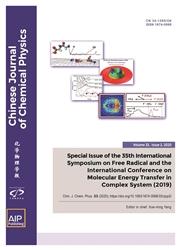用超快拉曼光谱探测溶剂化对光激发四极供体-受体-供体分子的影响
IF 1.2
4区 化学
Q4 PHYSICS, ATOMIC, MOLECULAR & CHEMICAL
引用次数: 0
摘要
对称和四极性给体-受体-给体(D-A-D)分子通常表现出从离域分子内电荷转移(ICT)态到定域ICT态的激发态电荷再分配过程。通过各种超快时间分辨光谱对这种电荷重分配过程的实时直接观察进行了深入研究。飞秒受激拉曼光谱(FSRS)是通过跟踪分子内特定化学键的振动模式演变来确定激发态动力学的有力方法之一。本文选择4,4 ' -(丁-1,3-二炔-1,4-二基)双(N, N-双(4-甲氧基苯基)苯胺)分子,由两个中心相邻的炔(-≡C-)基团作为电子受体和两个分离的对称的N, N-双(4-甲氧基苯胺)分支作为电子供体组成,研究激发态光物理性质。结果表明,用飞秒受激拉曼光谱可以探测溶剂化引起的极性溶剂中激发态电荷重分布。研究结果为研究中心位置有相邻振动标记的对称四极性分子的光激发诱导电荷离域/局域性提供了一个基本的认识。本文章由计算机程序翻译,如有差异,请以英文原文为准。
Probing effect of solvation on photoexcited quadrupolar donor-acceptor-donor molecule via ultrafast Raman spectroscopy
The symmetric and quadrupolar donor-acceptor-donor (D-A-D) molecules usually exhibit excited-state charge redistribution process from delocalized intramolecular charge transfer (ICT) state to localized ICT state. Direct observation of such charge redistribution process in real-time has been intensively studied via various ultrafast time-resolved spectroscopies. Femtosecond stimulated Raman spectroscopy (FSRS) is one of the powerful methods which can be used to determine the excited state dynamics by tracking vibrational mode evolution of the specific chemical bonds within molecules. Herein, a molecule, 4,4′-(buta-1,3-diyne-1,4-diyl)bis( N, N-bis(4-methoxyphenyl)aniline), that consists of two central adjacent alkyne (-C≡C-) groups as electron-acceptors and two separated, symmetric N, N-bis(4-methoxyphenyl)aniline at both branches as electron-donors, is chosen to investigate the excited-state photophysical properties. It is shown that the solvation induced excited-state charge redistribution in polar solvents can be probed by using femtosecond stimulated Raman spectroscopy. The results provide a fundamental understanding of photoexcitation induced charge delocalization/localization properties of the symmetric quadrupolar molecules with adjacent vibrational markers located at central position.
求助全文
通过发布文献求助,成功后即可免费获取论文全文。
去求助
来源期刊

Chinese Journal of Chemical Physics
物理-物理:原子、分子和化学物理
CiteScore
1.90
自引率
10.00%
发文量
2763
审稿时长
3 months
期刊介绍:
Chinese Journal of Chemical Physics (CJCP) aims to bridge atomic and molecular level research in broad scope for disciplines in chemistry, physics, material science and life sciences, including the following:
Theoretical Methods, Algorithms, Statistical and Quantum Chemistry
Gas Phase Dynamics and Structure: Spectroscopy, Molecular Interactions, Scattering, Photochemistry
Condensed Phase Dynamics, Structure, and Thermodynamics: Spectroscopy, Reactions, and Relaxation Processes
Surfaces, Interfaces, Single Molecules, Materials and Nanosciences
Polymers, Biopolymers, and Complex Systems
Other related topics
 求助内容:
求助内容: 应助结果提醒方式:
应助结果提醒方式:


